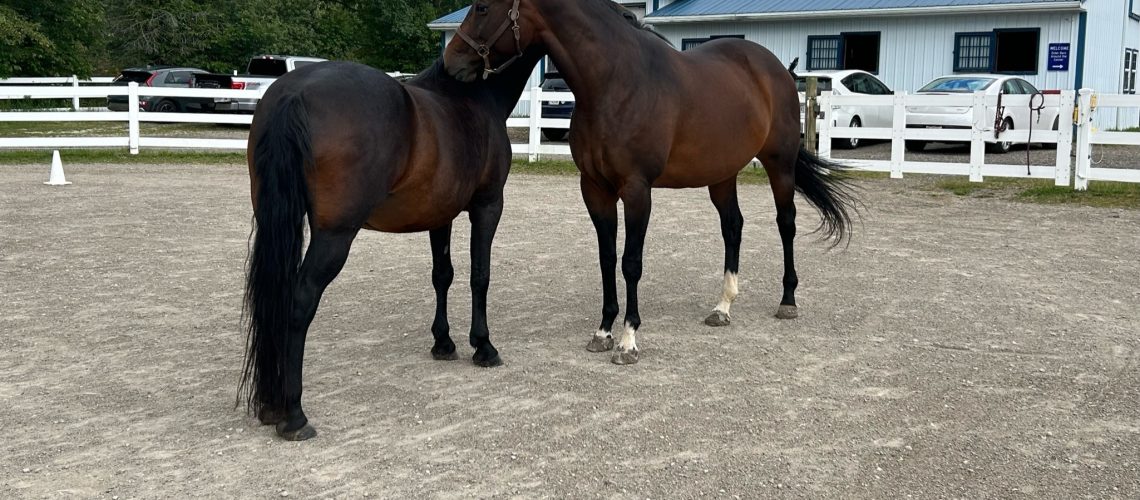
Dialectical Behavior Therapy Incorporating Horses
Dialectical behavior therapy (DBT) is a type of talk therapy (psychotherapy). It is specially designed for people who experience emotions very intensely. DBT is adapted from Cognitive Behavioral Therapy (CBT), which is a type of talk therapy that helps people understand how thoughts affect emotions and behaviors.
Dialectical Behavior Therapy was developed in the 1970s by Dr. Marsha Linehan, an American psychologist. “Dialectical” means combining opposite ideas. DBT focuses on helping people accept the reality of their lives and their behaviors, as well as helping them learn how to change their lives, including their unhelpful behaviors (Cleveland Clinic).
There are four main sets of skills taught in DBT. Distress Tolerance skills, Mindfulness skills, Emotion Regulation skills, and Interpersonal Effectiveness skills. Let’s look a little more closely at each of these skill sets.
Distress Tolerance skills help us cope with overwhelming emotions. They include distraction and self-soothing skills. One distress tolerance skill that you can use anywhere is the “5,4,3, 2, 1 Game” where you find 5 things you can see, 4 things you can touch, 3 things you can hear, 2 things you can smell, and one thing you can taste.
Mindfulness is “paying attention in a particular way: on purpose, in the present moment, and nonjudgmentally.” (Kabat-Zinn 1994: 4) The benefits of mindfulness include: stress reduction and relaxation, mood regulation and stabilization, increased self-regulation, greater understanding of self, deeper sense of empathy for others, and developing a sense of connection with other people/things.
Emotions are electrical and chemical signals in your body that alert you to what is happening. These signals often begin with your senses then they travel to your brain where they are processed in an area called the limbic system, which specializes in observing and processing emotions so that you can respond to emotional situations. The limbic system is also connected to the rest of your brain and body so that it can tell your body what to do in response to an emotional situation. Emotions are important to survival, memory, coping, communication, pleasure and pain. The emotional regulation skills are: recognizing your emotions, overcoming the barriers to healthy emotions, reducing your physical vulnerability, reducing your cognitive vulnerability, increasing your positive emotions, being mindful of your emotions without judgment, emotion exposure, doing the opposite of your emotional urges, and problem solving.
Interpersonal Effectiveness skills are just that–engaging in relationships with others in an effective way that builds connection and helps get our needs met. These skills include negotiation, assertive communication style, and setting effective boundaries with others.
Horses make wonderful partners for learning DBT skills.
Distress Tolerance skills: Sometimes just arriving at the barn is a distraction. Being in nature and working hands on with horses allows us to practice self-soothing and sensory activities. We can practice being non-judgemental with the horses, who model non-judgement in their interactions with each other and with us.
Mindfulness: Horses help us learn to be in the present moment. We have to pay attention to our surroundings, learn to read their body language, and stay connected to ourselves in order to be able to experience connection with them. Research shows that people are more mindful in the presence of horses. (Burgon, 2013; Earles, 2015)
Emotion regulation skills: We have to regulate our emotions in order for horses to want to partner with us. We can learn to identify our emotions and breathe through them in a way that will keep us in control of our bodies and thoughts. When we are able to effectively regulate our bodies we can engage with horses and begin to build relationships. We often have to solve problems when working with horses both on the ground and mounted.
Interpersonal effectiveness skills: We have to be assertive in our bodies and our words to work safely with horses. Horses set clear boundaries with each other and can model effective boundary setting as well as provide practice for setting effective boundaries in relationships. We have to know what we want and be confident in communicating our needs to the horses. These skills are essential in effectively communicating with other humans as well.
The therapists at In Step With Horses have training on dialectical behavior therapy skills and their applications in the arena.
References:
Kabat-Zinn J. Wherever you go there you are: Mindfulness meditation in everyday life. New York, NY: Hyperion; 1994. [Google Scholar]
Burgon, HL (2013). Horses, Mindfulness and the Natural Environment: observations from a qualitative study with at-risk young people participating in Therapeutic Horsemanship. International Journal of Psychosocial Rehabilitation. Vol 17(2) 51-67
Earles JL, Vernon LL, Yetz JP. Equine-assisted therapy for anxiety and posttraumatic stress symptoms. J Trauma Stress. 2015 Apr;28(2):149-52. doi: 10.1002/jts.21990. Epub 2015 Mar 17. PMID: 25782709.
TLDR: Working with horses is a wonderful way to experience and practice DBT skills. Being at the barn allows us to engage in a pleasurable activity that engages all of our senses (distress tolerance) and helps us to be in the present moment (mindfulness). Here we can learn to be aware of and tolerate our emotional experiences (emotion regulation) while engaging with non-judgemental horses and humans using assertive communication (interpersonal effectiveness).

